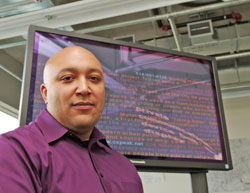Writing material: Text-messaging as public art

Jason Lewis in his offices at Hexagram, in the EV Building. Behind him, text as art.
Photo by kate hutchinson
Most people don’t think of text messages as art, but Concordia professor Jason Lewis wants to change that.
“We wanted to explore ways that cell phones and PDAs could be used as venues for creative expression, entertainment and interactivity.”
One of his most recent projects, CitySpeak, does just that.
Lewis, an assistant professor in Design and Computation Arts and the Graduate Certificate Program Director, presented his latest project to a packed auditorium in the final instalment of this year’s Defiant Imagination lecture series at the Montreal Museum of Fine Arts on March 22.
CitySpeak invites you to send text messages to giant projection and LCD screens around the world that normally are reserved for commercial interests. The text is processed using NextText text visualization software and a stream of interactive moving text is created. The result is art.
“We have these incredibly present devices (large screens), that are showing up in our cities and for the most part are used for advertising, like big visual bullhorns to catch people’s attention and sell them things. But they can also be avenues to create things of beauty.
“For me what was interesting was finding ways that we could combine small scale devices like cell phones and PDAs with extremely large scale displays.”
The CitySpeak web site explains that participants can use the displays to leave comments, have conversations or play with the visual characteristics of text.
“This brings together an interest in interactivity, an interest in visual language, and an interest in graffiti and in finding ways to mark up public space, which is something that in general we aren’t allowed to do.”
Lewis sees a link to graffiti ,defined as “a place where the visual and linguistic are combined in very expressive ways.”
Lewis also writes poetry, and he sees a connection there as well. Poetry is “a way of trying to remove all the unnecessary and be left with only the most essential elements of language.”
However, it’s the leap to digital language that is the most striking feature of his art.
“The digital is material, a material that needs to be explored the same way that we work with stone and sculpture.”
Johanna Drucker, an English professor at the University of Virginia, once said the electronic document has no stable material identity. It exists ultimately as disembodied code, and thus bears no information in its form.
“I don’t think this is true,” Lewis said.
“All that is digital is being realized through a very material manner, circuits. And there is a second level, code.”
According to Lewis the computer languages that digital artists work with are as much a part of the art as the product itself, since they limit what can and cannot be done.
“The materiality, the substance that you are actually working with is very present when you are working in the digital media.”
The CitySpeak project has been displayed for short periods of time on screens in large urban areas all over the world.
Montreal bylaws limit the opportunities for using public display space. Lewis appreciates this as a citizen, but is frustrated as an artist. He hopes to bring the project to semi-private spaces, like Internet cafés, in the near future.
For more information about CitySpeak, click here. Lewis’ work can also be seen at www.thethoughtshop.com
